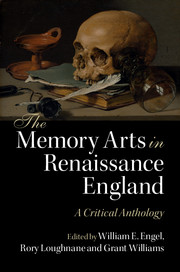Book contents
- Frontmatter
- Dedication
- Contents
- List of figures
- Acknowledgements
- A note on abbreviations
- Introduction
- PART I The art of memory
- Introduction to Part I
- I.1 Stephen Hawes, The Pastime of Pleasure (1509)
- I.2 [Laurence Andrewe], The Mirror of the World (1527)
- I.3 Peter of Ravenna, The Phoenix (1548)
- I.4 Guglielmo Gratarolo, The Castle of Memory (1562)
- I.5 Hugh Plat, The Jewel House of Art and Nature (1594)
- I.6 William Basse, A Help to Memory and Discourse (1620)
- I.7 John Willis, The Art of Memory (1621, 1661)
- I.8 Henry Herdson, Ars memoriae; the Art of Memory Made Plain (1651)
- I.9 Richard Saunders, Art of Memory (1671)
- I.10 Marius D'Assigny, The Art of Memory (1697)
- PART II Rhetoric and poetics
- PART III Education and science
- PART IV History and philosophy
- PART V Religion and devotion
- PART VI Literature
- Index
- References
I.9 - Richard Saunders, Art of Memory (1671)
from PART I - The art of memory
Published online by Cambridge University Press: 05 August 2016
- Frontmatter
- Dedication
- Contents
- List of figures
- Acknowledgements
- A note on abbreviations
- Introduction
- PART I The art of memory
- Introduction to Part I
- I.1 Stephen Hawes, The Pastime of Pleasure (1509)
- I.2 [Laurence Andrewe], The Mirror of the World (1527)
- I.3 Peter of Ravenna, The Phoenix (1548)
- I.4 Guglielmo Gratarolo, The Castle of Memory (1562)
- I.5 Hugh Plat, The Jewel House of Art and Nature (1594)
- I.6 William Basse, A Help to Memory and Discourse (1620)
- I.7 John Willis, The Art of Memory (1621, 1661)
- I.8 Henry Herdson, Ars memoriae; the Art of Memory Made Plain (1651)
- I.9 Richard Saunders, Art of Memory (1671)
- I.10 Marius D'Assigny, The Art of Memory (1697)
- PART II Rhetoric and poetics
- PART III Education and science
- PART IV History and philosophy
- PART V Religion and devotion
- PART VI Literature
- Index
- References
Summary
About the author
Richard Saunders (1613–75), almanac writer and physician, was part of the intellectual circle of William Lilly, the celebrated ‘Christian astrologer’.
About the text
While his section on the divination of a person's character by reading the moles on his or her body is somewhat original, Saunders's tome on physiognomy and palmistry, including the section on Lull's artificial memory system presented here, is a straightforward if unattributed translation from Jean Belot's Oeuvres (1640). On the strength of the success of this richly illustrated folio, he published pocket-sized versions of excerpts on palmistry starting in 1663, and, in 1671, released a corrected and enlarged edition.
The arts of memory
Precisely because Saunders is so deeply indebted to earlier continental sources (Paracelsus, Della Porta and Belot), this work is a reliable English summary of the accumulated knowledge about the memory arts in general and Raymond Lull's combinatory mnemonics in particular (consisting of, in part, a set of wheels within wheels rotated to yield numerous combinations of possible propositions and memory sites). Following Bruno, Saunders highlights the organisational and generative principles of Lull's approach to make it accessible to attentive readers.
Textual notes
Saunders physiognomie, and chiromancie…whereunto is added the art of memory (London, 1671), 3C2r–3C4v.
Art of Memory
Chapter 1
Artificial memory is nothing but an art to assist the natural, for without the one the other cannot subsist. If there were not a natural memory, the artificial would not avail much; but the natural having some inclination to an art or science, doubtless the artificial is very serviceable to it, and by the artificial that may be shortened, which otherwise would take up a long time, and this is it wherein Raymundus Lullius hath bestowed his endeavours, and by his exquisite learning found out the perfection of this short art and artificial memory, which although he found out, yet did he conceal it under riddles and amphibologies that the learned might be at the expense of some leisure to know and attain it.
- Type
- Chapter
- Information
- The Memory Arts in Renaissance EnglandA Critical Anthology, pp. 88 - 94Publisher: Cambridge University PressPrint publication year: 2016



